Track and field houses many events, all of which will require specialized shoes in order for you to perform at your very best. First and foremost, there are varied disciplines for the track, with spikes having subtle differences that will affect your running. Then you have field shoes, which also has separate specialties such as jumping and throwing events. And one pair of shoes just won’t cut it if you’re into more than one type of event. There are actually a ton of factors you’ll have to consider to find the right pair(s) for you. That”s why we decided to throw together this useful little guide on how to choose track spikes and field shoes. It’ll go over everything you need to know including event specific spikes and shoes, types of spikes, spike length, how to fit them, tips, and more. Are you ready? You better be, let’s start!
How to Choose Track Spikes and Field Shoes
What Events Are You Into?
Whether you participate in track events or field events, there are different shoes for each discipline. Shoes meant to be worn on the track are specially referred to as track or running spikes, whereas shoes for field events can be separated into “jumping spikes” and “throwing shoes”.
Track Events
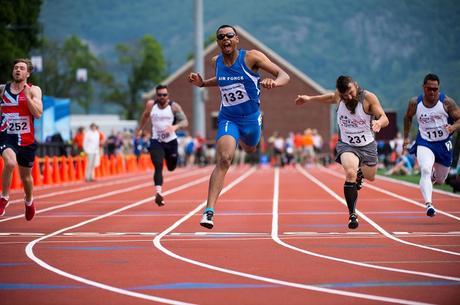
Sprints – Usually anywhere from 200-400m where there are either one or no turns. While sprinting, you are encouraged to run on the ball of your forefoot. That’s why most sprinting spikes only have spikes in the very front of the outsole. There is very little padding making them exceptionally light. They also tend to have the most amount of holes to house spikes. Most sprinting spikes have stiff plates in order to provide a more responsive and springy feel. If you’re sprinting closer to 400m, it might be wise to find spikes that are a little more flexible.
Middle-distance – Anywhere from 800-5000m, middle-distance spikes will help you run fast while remaining comfortable for longer distances. They have some attributes of both sprinting and long-distance spikes, such as a balance of flexibility and rigidity, some cushioning, and torsion so that turning will be easier.
Long-distance – Long-distance events are anything over 5,000m. Spikes for these types of events will be light, flexible, and durable. In fact, long-distance spikes will be the most flexible while featuring lots of cushioning to keep you pain-free and comfy.
Hurdles – Most hurdlers look for either a flexible sprint spike or middle-distance spike since there is some heel cushioning to prevent injuries.
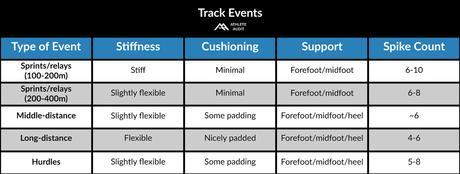
Jump Events
The triple jump, long jump, and pole vault are very similar, and you can see it in the similarity of the shoes (most resembling sprint spikes where you run on the ball of your forefoot). Spikes for these three events will have a thin, full-length midsole for support, stability, and comfort while planting. The high jump spikes are a bit different, however.
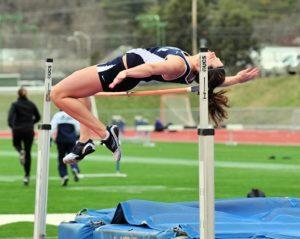
Triple jump – Spikes are labeled TJ, and may have a slightly different heel than LJ spikes with lots of cushioning to prevent heel bruises.
Pole vault – Often labeled PV but can also be LJ/TJ spikes since they are very similar. Features a heel-to-toe offset to help make the transition from running to vaulting easier.
High jump – Similar to the javelin boots where spikes can be found on the front and heel of the shoe. A strap is very common to provide lockdown/support of either the forefoot or midfoot.
Throwing Events
Most throwing shoes will be flexible with a wide, flat-bottom outsole (with the exception of the javelin throw). Categorized as either rotational shoes for better spin, OR glide shoes with a textured outsole for grip (again, with the exception of the javelin throw).
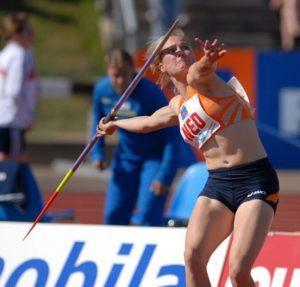
Hammer throw – Features a smooth and slightly rounded outsole to allow for natural rotation. Some brands label these shoes as rotational or hammer/discus.
Discus throw – Often has a flat, wide base and a smooth, rounded outsole as well. Some brands label these shoes as rotational or hammer/discus.
Shot put – Should be slightly curved with a wide, flat heel and slightly textured outsole for more lateral stability. Some brands label these shoes as SD or shotput.
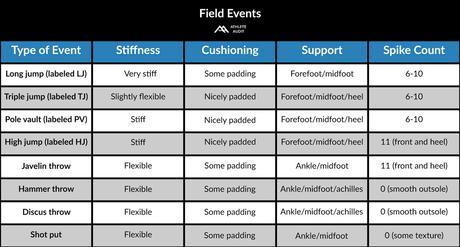
Spike Types/Length
Types
Spike types, or “elements”, come in a variety of shapes that each serve a specific purpose. Always check to see what spikes are allowed on a track before you use them.
Pyramid – A classic spike meant for hard tracks, rubber, dirt, and grass. Most common length is 1/4″.
Needle/pin – Also known as “slim” since they are slimmer than pyramid spikes. Best on all-weather tracks. Most common size is 3/16″.
Blanks – Blanks, or “studs”, have no spikes and should be worn indoors or on tracks where spikes aren’t allowed. You also use them to fill in spike wells.
Christmas tree – Also known as “X-mas tree” or compression spikes, their unique design prevents the spikes from sticking into the track too much. Made for softer tracks like rubber or tartan surfaces. Most common length is 1/4″.
Tartan – Has a cylindrical shaft and a pointy spike at the top; for rubber tracks only.
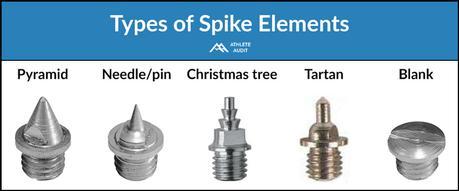
Length
Spike elements also come in a variety of lengths as well, and how long your spikes are can really affect the way you run. Spikes come in 1/8 “to 5/8″ lengths, and some events only allow a certain length, so it’s also worth it to check what spikes you can use beforehand. If you are ever in doubt, go with the 1/4″ spikes since the maximum allowable spike length for most outdoor tracks is 7mm, or roughly 1/4″. For muddy tracks, use longer spikes such as 1/2″ or 5/8″. For javelin throwers, go with 7/16″ or 1/2”.
***Always carry a few extra sets of spikes in different lengths as well as a wrench or needle nose pliers so you can be ready for any race!***
How to Fit Track Spikes and Field Shoes
- Socks or no socks? Some athletes don’t wear socks because they like the better fit and feel for the track. Others enjoy wearing socks because it prevents blisters and burns. Whatever your choice is, determine early on what camp you’ll be in and take that into account when sizing. Even thin socks can change the fit of shoes completely. If you do choose to wear socks, wear them while trying on a new pair of spikes.
- Try on track spikes in person for the best fit. If you must purchase online, make sure returns are available and order a few similar sizes and return the ill-fitting ones.
- Depending on what event you’re participating in, make sure there is proper support in the right areas, whether it’s the forefoot, midfoot, ankle, heel, or achilles.
- Track spikes and field shoes should fit very snugly (like second skin) for maximum running efficiency. Most track and field athletes size down a half or full size from their running shoes.
- If possible, try jogging in the shoes to see if they fit right while in motion.
- You should have a tiny bit of wiggle room for your toes and they should not feel pinched or cramped.
- Don’t expect there to be a ‘break-in’ period with track and field shoes. If a pair of spikes or shoes are really uncomfortable or painful, chances are they’ll stay that way.
Other Essential Criteria
- Comfort – When learning how to choose track spikes and fields shoes, comfort should be the number one priority, especially if it’s your first pair. Don’t buy into trends or the latest technology if a pair of shoes doesn’t feel right. Running comfortably is always better than running with pain on your mind.
- Weight – Track and field shoes are built to be super lightweight, especially track spikes. Sprinting spikes are often the lightest of the bunch since they have very minimal cushioning and support, and any extra shaved weight without compromising on functionality can only be seen as an advantage
- Price – Track spikes can vary in price anywhere from around $50 for mid-range spikes and $100 or more for high-end models. It’s really up to you how much you’re willing to spend on a pair of shoes, but our best advice is to always purchase somewhere in the mid-range when starting out. It provides the best value in terms of durability and performance. You’re not buying a cheap shoe that will fall apart quickly and you’re not spending too much on technology and features you don’t need yet.
- Durability – Durability really depends on the types of materials used as well as the craftsmanship. In our opinion, it’s always better to spend a bit more on a pair of spikes that will last longer. Having a comfortable pair of spikes for multiple seasons is well worth it in the long run.
- Breathability – Most track spikes have airy uppers and have lots of ventilation, so breathability shouldn’t ever be an issue.
- Stiffness – Stiffness of the sole plate plays a big role in different events. While you’ll want stiffness in some events, you might want flexibility in others.
***Tips On How to Choose Track Spikes and Field Shoes***
- Purchase event specific spikes and don’t use them for anything else except for that discipline. Doing so may lead to injury.
- Find the right spikes and length for your event, and get yourself different sets just in case.
- Find out how much stiffness/flex, cushioning, and support a pair of spikes or shoes should have for an event and prioritize those attributes when shopping.
- Like most athletic shoes, track spikes and field shoes should be extremely comfortable for your feet. Comfort trumps fashion, always.
- Always try before you buy (or make sure you can return them if buying online) and test drive them first for functionality.
- Figure out how you’ll want your spikes to fit and if you’ll be wearing socks with them or not.
- New models of track spikes come out every year, but not much will change in regards to the design. Purchasing previous models is a good way of saving money.
- Buying mid-range spikes provide the best value in terms of durability and performance.

